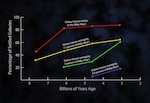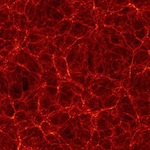Word doc
PDF (formatted and ready to go as a single newsletter page)
Simulating the Universe
Astronomy has historically been an observational rather than a laboratory or experimental science. Except for lunar scientists or meteorite collectors (who can touch rocks from other solar system bodies), most astronomers can only point large telescopes, collect electromagnetic radiation, focus it onto detectors, and analyze what they observe.
But now supercomputers and powerful computational techniques increasingly allow astrophysicists to experiment with the initial conditions and physical laws for astronomical processes, including the formation of the universe. Indeed, large cosmological simulations—computational working models—are the basis for much current astrophysical research.

Snapshot from the Bolshoi simulation at a red shift z=0 (meaning at the present time), showing filaments of dark matter along which galaxies are predicted to form.
CREDIT: Anatoly Klypin (New Mexico State University), Joel R. Primack (University of California, Santa Cruz), and Stefan Gottloeber (AIP, Germany).
Latest and greatest: Bolshoi
The most accurate cosmological simulation yet made of the evolution of the large-scale structure of the early universe is being described in a series of research papers that began to be published in Astrophysical Journal and other journals in October 2011.
Named “Bolshoi”—the Russian word for “great” or “grand”—the simulation models the evolution of a representative volume of the universe about 1 billion light-years on a side, a volume that would contain over a million galaxies. The computer code took 6 million CPU hours to run on the Pleiades supercomputer at NASA Ames Research Center. The calculated results—spectacular visualizations of what the universe was like at 180 different times from the Big Bang to the present epoch—were saved for later analysis. Some of the raw data plus detailed summaries and analyses of the outputs are now publicly available to the world’s astrophysicists.
Co-principal investigators Joel R. Primack (University of California, Santa Cruz) and Anatoly Klypin (New Mexico State University) based the Bolshoi simulation on both the most precisely known observational data and the most robust physical theory.
For observation, Primack and Klypin based the Bolshoi simulation on a meticulous data set combining ground-based observations with an extended run from the highly successful NASA Explorer mission WMAP (the Wilkinson Microwave Anisotropy Probe). WMAP measured the detailed anisotropy (unevenness of temperature and other characteristics) over the whole sky of the cosmic microwave background radiation left over from the Big Bang that formed the universe 13.7 billion years ago. The anisotropy reveals a wealth of information about the history and composition of the early universe.
For theory, the Bolshoi simulation is based on the Lambda Cold Dark Matter cosmogony (ΛCDM for short), now accepted as the standard modern theoretical framework for understanding the formation of the large-scale structure in the universe. Ordinary atomic matter makes up less than 5 percent of the universe; only about half a percent is visible as stars, nebulae, dust, and planets. Some 23 percent of the universe is made of invisible, transparent “cold dark matter,” felt only through its gravitational influence. ΛCDM predicts that repeated mergers of smaller clumps of dark matter end up creating bigger dark matter “halos,” within which galaxies and clusters of galaxies form and congregate. The Greek letter lambda (Λ) in ΛCDM represents the fact that 72 percent of the universe is “dark energy,” causing the universe’s expansion to accelerate. Since ΛCDM says the universe is mostly made of invisible dark matter and dark energy, it might better be called the Double Dark theory.
Revealing the invisible
Thus, the Bolshoi simulation models not just how the minority of the visible universe of stars, gas, and dust evolved, but also how the vast majority of the invisible universe evolved—rendering the invisible visible for astronomers to study, and to predict structures that astronomers can seek to observe. - Trudy E. Bell, M.A.
Further reading
Details about the Bolshoi simulation appear at http://hipacc.ucsc.edu/Bolshoi/ .
The University of California High-Performance AstroComputing Center (UC-HIPACC), based at the University of California, Santa Cruz, is a consortium of nine University of California campuses and three Department of Energy laboratories (Lawrence Berkeley Laboratory, Lawrence Livermore Laboratory, and Los Alamos National Laboratory). UC-HiPACC fosters collaborations among researchers at the various sites by offering travel and other grants, co-sponsoring conferences, and drawing attention to the world-class resources for computational astronomy within the University of California system. More information appears at http://hipacc.ucsc.edu .




















